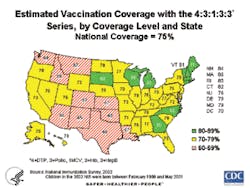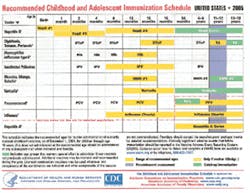Resurgence of childhood diseases: Educate yourself and your patients
Measles, mumps, chicken pox, diphtheria, rubella, influenza, viral hepatitis ... could dental hygiene practitioners be exposed to, or be at risk for, contracting these childhood diseases?
Do all of the patients you treat have the recommended childhood vaccinations? Do we ever ask if they have had the recommended series of vaccines? Could dental hygiene practitioners be the missing link in educating patients on these diseases and the recommended course of vaccines?
Now more than ever, the population of the United States - the “melting pot” of all nations - is a mix of societies, cultures, beliefs, and attitudes that impact the health-care community. The challenges health-care providers face go beyond the education and oral health-care services we provide for our patients. Perhaps immunizations are an assumption to many dental professionals, giving a false sense of security about our “immunity” to diseases of the past.
Not so long ago, our nation was plagued with many different diseases from childhood to adulthood. The result was much suffering and death. Today, through years of research and clinical innovation, these diseases no longer have to threaten our nation. As health-care professionals, we have the responsibility to keep this viable threat from knocking at our door once again.
A vast number of articles and studies indicate many parents in America are choosing not to vaccinate their children. Parents’ reasons vary, ranging from economic status, misinformation, religious beliefs, association standards and hearsay.1 Parents are allowed to “sign off” or “opt out” of vaccinating their children.
An article in the 2004 issue of the University of Michigan’s Journal of Law Reform states, “The rise in parents opting out has caused the American Medical Association grave concern, with many experts decrying the rise of so-called ‘exemptions by convenience.’ In some areas, nearly one out of every five children have not received their recommended vaccines. The consequences are serious, not only for the unprotected children, but for the rest of society as well.”1
Dental professionals take it for granted that all patients have had the regular series of recommended vaccines. This series of vaccines includes hepatitis B, diphtheria, tetanus, pertussis, influenza type B, inactivated poliovirus, measles, mumps, rubella, varicella (chicken pox), pneumococcal (pneumonia), influenza, and hepatitis A (see Figure 1).
Vaccines for all childhood diseases are available, but do most people have access to or take advantage of this preventive treatment? The following statistic would indicate “not to the best of our ability as a nation.” A 2002 study from the CDC/NIP reveals vaccination coverage in the United States is at 75 percent (see Figure 2). That figure in layman’s terms, makes the grade of “C.” What does this indicate for the health and safety of our population?
Dental hygienists need to educate and inform the profession of the health status of our patient population nationally and in our own communities. One of our responsibilities is to educate our patients against caries, a preventable disease. Complete oral health care includes the health and wellness of the entire body. It is a natural fit, as part of our professional responsibility, to educate our patients against childhood diseases, which are also preventable. To achieve a healthy mouth, prevention is the key. This is the same attitude that must be adopted by dental professionals as advocates for the prevention of childhood diseases.
Healthy People 2010 has identified 10 leading health indicators to track the progress of the health of the nation, and immunization is one of them.3 We can become integral partners in the campaign to achieve one of the national health objectives of 2010. This objective states, “We would like to sustain more than 90 percent coverage of vaccines for children ages 19 to 35 months.”2 As Figure 3 notes, we are considered a team player for the promotion of oral health. Hygienists should be a source of health and wellness for the entire person.
Access and acceptance of vaccines are two component of the immunization issue. Within the “melting pot” of the United States, there are many cultures, societies, religious institutions, and organizations who choose not to send their children to “public” school. In the United States, public school is an elementary or secondary school controlled and maintained by civil authority, acting through an official board expending public money and open to all local children4. Various reasons support parents’ decisions. These range from religious and philosophical beliefs to freedom and individualism. Although all jurisdictions in the United States require proof of vaccine for school entrance, parents can legally refuse vaccinations on medical grounds in all 50 states.5,7
By not attending public school, these children do not have to provide the required documentation for proof of vaccination needed to enter school. The one fail-safe mechanism in place to help ensure proper vaccination among the masses of children is bypassed. It is through this effort that disease is halted before it reaches the most vulnerable members of our population. Dental hygienists already support school-based oral health programs. Again, what a perfect fit for us to expand our programs to incorporate the wellness of the whole body including the prevention of childhood diseases.
Rural, isolated communities also have an impact on the immunization issue. Within our diverse populations, one specific culture has significant impacts on rural education in 22 states and the province of Ontario.8 This prevalent culture also lacks the preventive practice of immunization. Only 16 to 26 percent of this population’s children have received immunizations against common childhood diseases.9
In rural and outlying areas, dental hygienists may be the first health professionals to have contact with children or adults needing health care. As hygienists, we may see these patients on a regular basis and have the opportunity to be educational health resources by helping parents make sound decisions regarding vaccines based on research and clinical evidence.
As conversations continue to swirl regarding the context of the Advanced Dental Hygiene Practitioner, an alliance could be formed with community health organizations based upon the need for access to health care. More and more, the ADA and ADHA continue to understand the importance and advancement of our profession by giving governmental consent to hygienists to perform additional clinical duties as a health practitioner. With our education and additional clinical responsibilities, the dental hygienist could be the next health professional to assist in providing vaccines and vaccine information. Coupled with our knowledge of evidence-based research and application in clinical practice, we can provide a win-win situation for all involved.
Kimberly S. Beistle, BA, RDH, MSA, CDA, is an assistant professor and program coordinator at Ferris State University. Kathleen Harlan, RDH, BS, MS, is an assistant professor and first year course coordinator at the same university.
References
1. Calandrillo, SP., Vanishing Vaccinations: why are so many Americans opting out of vaccinating their children? Univ of Mich J Law Reform, 2004 Winter, 37(2):353-440
2. US Department of Health and Human Services, Healthy People 2010 (conference ed, in 2 vols). Washington. D.C: US Department of Health and Human Services; 2000
3. www.nider.nih.gov/NewsAndReports/ReportsPresentation/HealthyPeople/Chapter1.htm
4. www.encarta.msn.com/encyclopedia_761554936/Public_School.html
5. Salmon, DA, Siegal, AW., Religious and philosophical exemptions from vaccination requirements and lesions learned from conscientious objectors from conscription., Public Health Rep, 2001 Jul-Aug; 116(4):289-95
6. Klicka, Christopher, Immunizations: A Parent’s Choice, Home School Legal Defense Association, November 2, 2004, www.hslda.org
7. McCormick, S., Vaccine Skepticism: Adverse Effects and Alternatives, November 13, 1995, www.gentlebirth.org
8. Dewalt, MW., Amish Schools in the United States and Canada, U.S; South Carolina; 2001-04-10
9. Adams, CE, Leverland, MB, The effects of religious beliefs on the health care practices of the Amish, The Nurse Practitioner, 1986 March; 11(3)
10. www.cdc.gov, Center for Disease Control and Prevention
11. www.aap.org, American Academy of Pediatrics
Legal requirements for vaccinations• All jurisdictions in the United States require proof of vaccine for school entrance.5
• Parents can legally refuse vaccinations on medical grounds in all 50 states, if specific criteria are met.7
• Religious exemption is allowed in 48 states.7
• Philosophical exemptions exist in 14 states.7
• Conscientious exemption exists in 16 states.6
null



